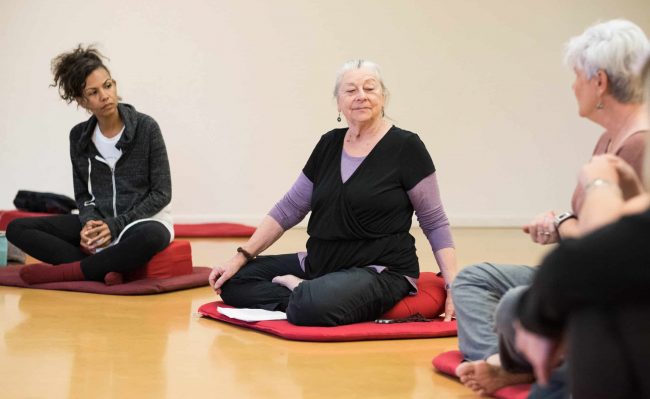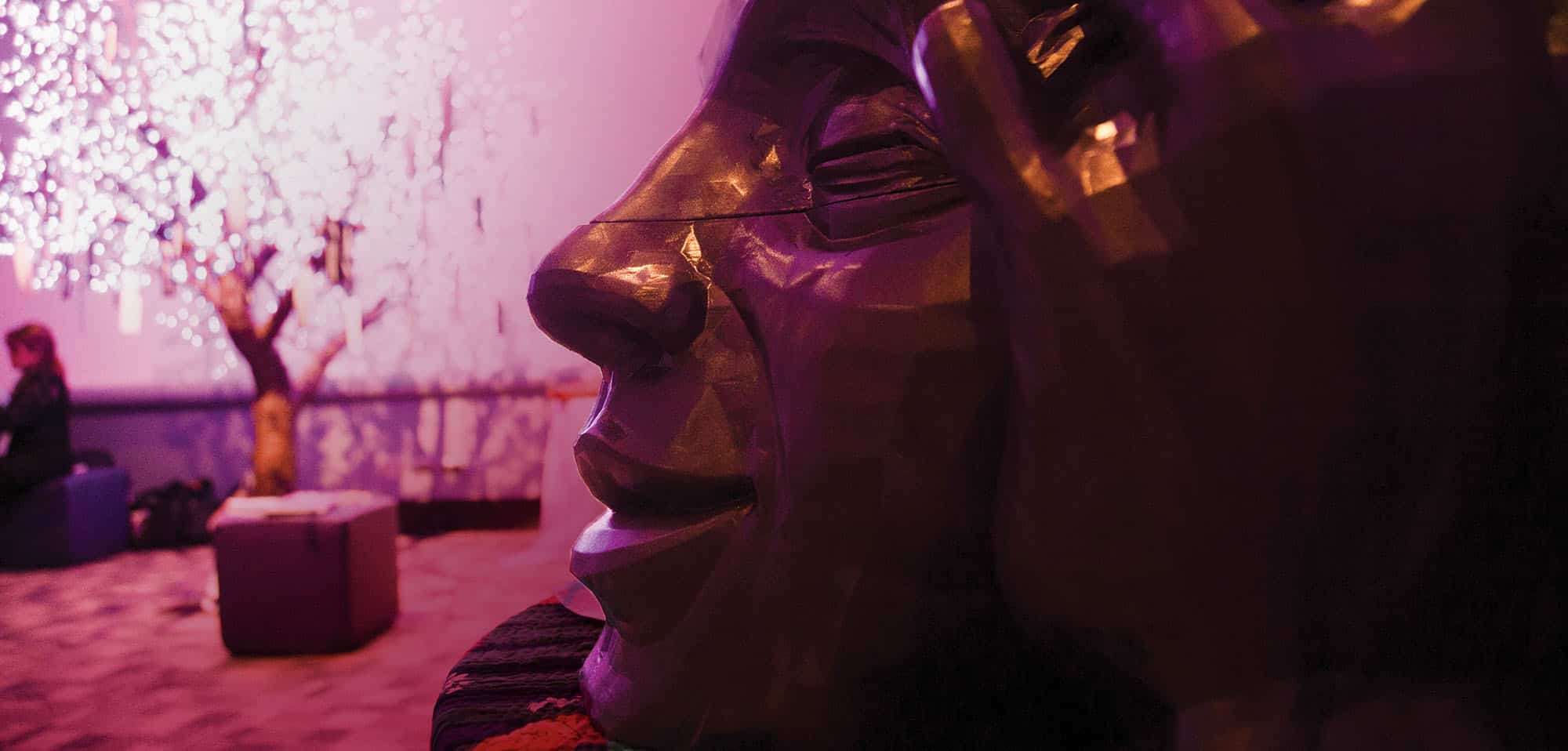Since its inception, Naropa has woven innovative contemplative practices into its curriculum and culture—merging millenia- old tradition with modern application. There are countless practices that inhabit our expansive 50-year history and below are just a few that have stood the test of time. Many of these practices were designed specifically with Western students in mind and their unique needs for approaching and understanding Eastern thought—informed by contemplative art, inherent human dignity, and working skillfully and compassionately with emotions. They represent Naropa’s place at the leading edge of marrying Eastern wisdom and Western education systems in the modern contemplative movement.
Maitri Space Awareness

Naropa’s founder, Tibetan Buddhist teacher Chögyam Trungpa Rinpoche, gave the maitri teachings at Naropa beginning in 1974. Maitri can be translated as “loving-kindness” or “unconditional friendliness.” Maitri Space Awareness Practice was developed by Trungpa as a method to cultivate a non-judgmental, non- critical, and non-goal-oriented attitude towards working with the mind and emotions to reveal the basic goodness at the core of our humanity. He adapted the concepts of the five Buddha families from his Tibetan Buddhist lineage, which focuses on the elements in each of us—earth, water, fire, air, space—and has colors and emotions associated with each of them, as well as corresponding “wisdoms” and “confusions” that manifest. The practice is done using different colored rooms to intensify distinct emotional and psychological states, bringing clarity and insight to these aspects of our experience.
Over the years, maitri practice has been integrated into the graduate and undergraduate curriculum. In BA and MA Psychology degrees, it is a fundamental staple for understanding the nature of mind and emotion, and for other programs, it’s a popular elective. Over the decades of its practice, many students have come to recognize their own patterns and befriend their inner worlds—developing genuine humor and compassion, which often leads to relaxation and fearlessness in working with and supporting others. Naropa still has on-site maitri rooms, which authorized classes use regularly, and hosts multi-week maitri retreats at our long- time offsite retreat partner, Drala Mountain Center. The practice has been with us for as long as we’ve been an institution and is cherished by so many for the ways it has clarified and embodied the wisdom of mind.
“Maitri can be translated as ‘love.’ It means a warm, friendly attitude. In making friends with someone, it means accepting their neurosis as well as their sanity. Maitri is an all-encompassing friendship that relates with the destructiveness of nature as well as with its creativity. But the first step is trust in ourselves. Such trust can only come about when there is no categorizing, no judgment, but a simple and direct relationship with our being.” —Chögyam Trungpa Rinpoche
Practice Day
For one day every semester, Naropa suspends classes to come together as a community for Practice Day. It began as a small experiment in the early 1980s. Judith Simmer-Brown, PhD, and Reggie Ray, PhD, of the Religious Studies department were exploring the question: what makes studying at Naropa different than anywhere else? While many universities offer a similar academic lens for examining world religions, Naropa stands out as a place that not only emphasizes study, but puts into practice what we learn, especially when it comes to our roots in Eastern contemplative traditions. And so Practice Day was founded starting in the Religious Studies department and eventually spread to the entire university. It’s become an integral element in the rhythm of each semester.
Practice Day has had many iterations and formats throughout time, and now usually unfolds with our community coming together in the morning for a sitting and walking meditation, followed by some creative form like devotional singing or movement, then a presentation or transmission from a wisdom holder, and breakout workshops in the afternoon led by faculty and staff. It’s a time and space to come together, build community, and connect more deeply to ourselves as individuals through contemplative practice. It is a uniquely Naropian tradition, beloved by many, and embodies our collective commitment to practice what we preach.
“Practice is what brings our aspiration to be wise and compassionate into action, and every semester everything stops so we can collectively remember what really matters, which is transforming ourselves so we can transform the world.” —Cassandra Smith, Naropa Alumnx (MA Religious Studies, ’23) & Director of Marketing at Naropa
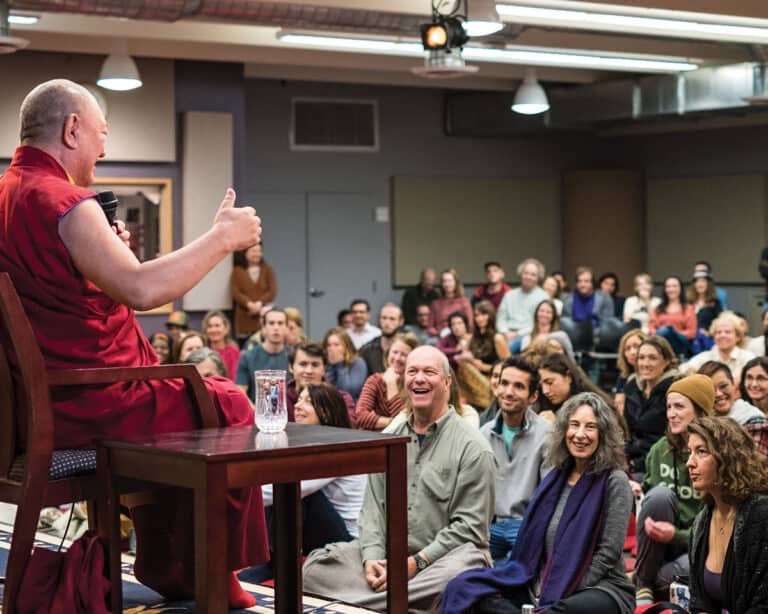
The Bow
If you’ve been around anything Naropa, then you likely know the collective bow that opens and closes just about every space we engage in together, whether that’s the start of a class, a presentation, a meeting, Practice Day, or an event. The bow is a loved and quintessential ritual.
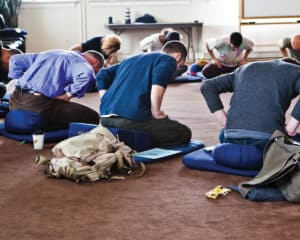
It’s a simple gesture: you arrive in your seat; your spine is as straight as possible, and you settle into a dignified posture—feeling a sense of warriorship, nobility, and compassion within yourself. You feel your own body and become aware of others and the space around you. Your eyes are open, your senses are present. You fully arrive in the moment. Then, you bow as an offering of humbleness, recognizing in others the same dignity you cultivated in yourself, as they offer the same in return. It’s a brief ritual, yes, but many can attest: it changes the atmosphere of the room. Something shifts when you connect to your own dignity, offer it, and recognize it in others.
The ritual leaves a lasting impact on those who flow in and out of Naropa’s doors, and for good reason. While the simplicity of it seamlessly flows through our daily actions as a university, there is an aspect of it that is revolutionary. Our society prioritizes fast, easy, efficient work. Taking the time to pause in a moment of pregnant silence with a group of people and offer our humility to the space is an almost rebellious act, directly addressing the capitalistic tendency to see human relationships as mere transactions. In these moments of presence, whether at the university or when our students take this practice beyond it, little ripples are released into the world proclaiming the goodness of human nature and the beauty of presence, which is always available to us if we take the time to recognize it.
The Warrior Exam

A powerful rite of passage in many courses, the Warrior Exam is still a staple of most classes’ final exams—inviting students to speak to their own learning and insight spontaneously, unselfconsciously, and in-the-moment.
The Warrior Exam has been a method of evaluation since Naropa’s beginnings. It’s an oral exam that begins with all students sitting in a circle around two meditation cushions that face each other. In the middle, a questioner and respondent arrive on their cushions. They bow to each other as a subtle embrace of each other’s innate wisdom and then begin. The questioner has exam questions prepared based on working with the student closely, and there’s also the opportunity to embrace spontaneity and go off script. The respondent stays centered and ready to meet each question and respond, remembering what they’ve learned and allowing their answers to arise with the freshness of the moment. In each class, the subject matter and questions differ, but the essence remains the same: it asks a student to call forward what they’ve truly gathered in the classroom that will carry with them beyond its walls, let go of carefully planned responses, and open to the embodied knowing that’s alive in their experiences and studies.
This classroom method was developed by Trungpa as a way of drawing out the spontaneous insights of students. It has endured with great appreciation, and sometimes great resistance, by those who have participated. Even for those who have never really liked the format, the pressure, or being placed on the spot, the core lesson of the practice remains invaluable: can you remain in the moment and rise to the occasion? Can you stay in your seat when you don’t know, when you’re uncomfortable, and continue anyway? Cultivating this skill can serve students for a lifetime as they pursue their own visions with an attitude of perseverance. It’s an enduring and valuable element of a contemplative education.
Mudra Space Awareness
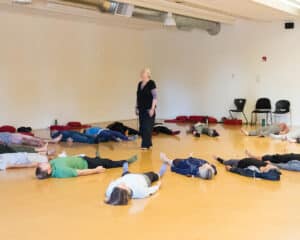
Mudra Space Awareness is another contemplative practice given by Trungpa in the early years that carries a long legacy at Naropa, particularly through the former Performing Arts program. The practice was adapted from Tibetan Monastic Dance and was designed as a way to awaken the mind and teach body and space awareness by using them as points of concentration.
The foundational mudra exercise is called the “Intensification of Space” or “The Lizard.” Practitioners are taught to first become aware of the space around them and then intensify that space in order to recognize the unity of body and space. This is done through guided visualization. While lying on their backs in a specific posture, they extend their awareness into the vastness of space, both inside and outside the room. They are then guided through an imagined journey that culminates in the sensation of intensified space coming into contact with the body, leading to a physical response of intense awareness and muscle tension. Then all at once, they release everything and feel the relaxation and vastness that often follows. This process done in rounds helps synchronize the mind and body, tame mental chaos, and foster gentleness and non-aggression. It also deepens the practitioner’s understanding of the interplay between form and space, self and other, mind and matter.
Mudra Space Awareness was a primary component of the MFA in Contemporary Performance, offered between 2005–2019. It taught students how to take on and release forms, which provided a powerful analog to the characters they played. Today, it’s still taught through Extended Campus and in the larger Boulder community by one of Naropa’s original teachers and beloved faculty member, Lee Worley. The practice has even reached international audiences when students of Lee organized a monthlong European teaching tour, beginning in France and ending in Greece. In addition, groups of students who have learned with Lee still get together for practice meetups, and its significance as a contemplative art within our community continues to live on.
